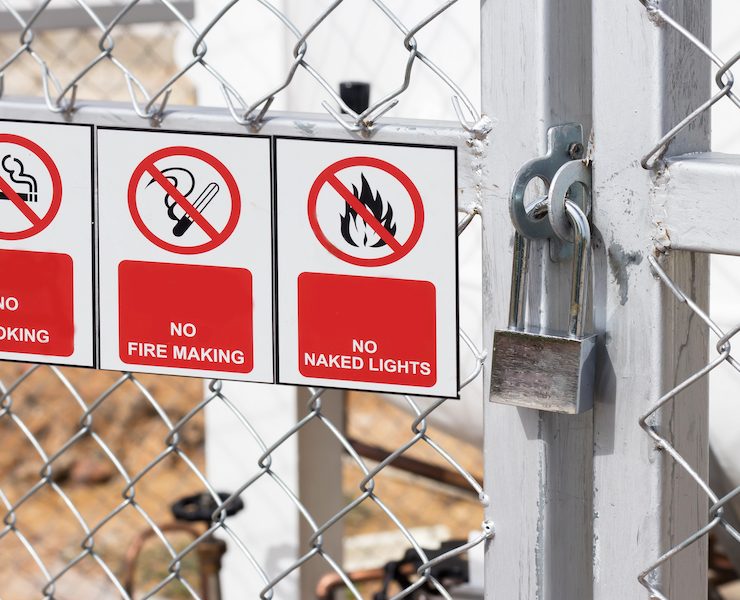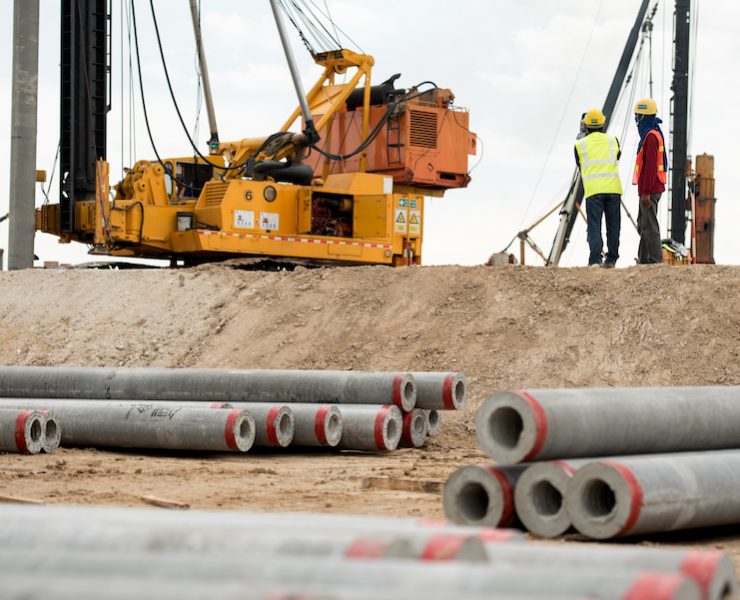The Ultimate Guide to Transporting Hammers, Rigs, and Other Heavy Equipment
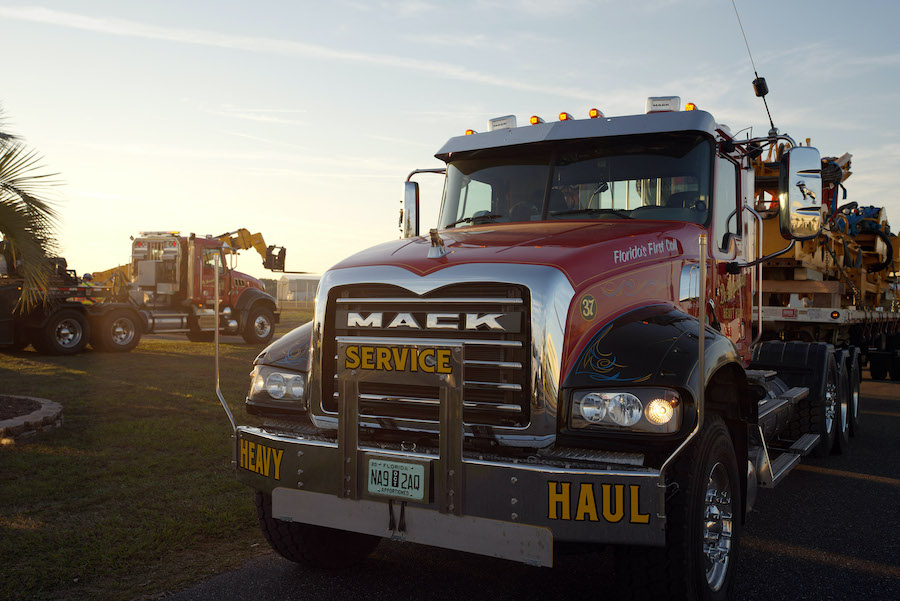
View the complete article here.
Intro
A critical part of any construction project is figuring out how you are going to get all that giant equipment to and from the site. There’s more to hauling heavy machinery than just throwing it on a truck and driving over. It takes careful planning to properly move any piece of equipment. In our ultimate guide, we tell you how to haul heavy machinery from point A to point B (and back) safely.
DIY or Hire?
Unless you’ve got an experienced heavy hauler on your team, moving huge pieces of equipment is best left to the professionals. Following Department of Transportation (DOT) requirements at the federal, state, and local levels is daunting enough. The money you might save will pale in comparison to the cost of fines you may pay for doing it wrong. The liability risk you take on should there be an accident could mean the end of your business. But, you know, your choice.
General
No matter the type or size of the load, there is a general set of procedures for preparing equipment for transport.
Document Job Requirements
You’re going to need this information to get heavy haul bids, hire or assign the right workers, develop a transport timeline, and to perform a risk assessment. It will include the type of equipment, dimensions, weight, construction site details, etc.
Risk Assessment
Document all the risks associated with the transport. This could be weather and road conditions, oversized or particularly heavy equipment, challenges related to the construction site – anything that could result in an accident or delays. Determine specifically what steps will be taken to mitigate those risks. For example, taking a route that may be longer, but safer to travel. Or, plans to enhance the securement system.
Personal Protective Equipment (PPE)
The project manager should ensure that all needed PPE is provided. The supervisor should require all workers on the transport team to actually wear the PPE. A good pair of work boots, proper gloves, and a hard hat are small investments to make in the safety of your workers.
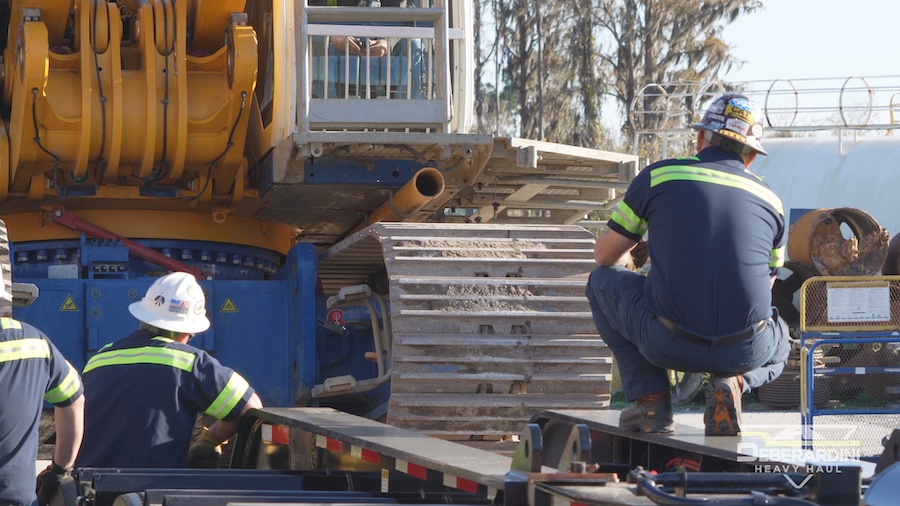
Inspection
The truck or trailer must be able to handle the weight of the equipment it is transporting. But it must also be in proper working order. Use a checklist to make sure the transporter inspects each item. This document will be part of the record to prove that the inspection was completed, when, and by whom. Report any issues to a supervisor prior to loading the equipment. The following four points are an integral part of the pre-loading inspection:
- Ensure the tires and tire pressure sufficient to handle the weight.
- Test the headlights and brake lights to ensure they are working. (This would be a fine time to wipe down the light covers.)
- Carefully inspected the brakes for wear.
- Inspect tie-down points. Typically states require four tie-down points for loads in excess of 10,000 pounds. Some machines, such as excavators, will require an additional tie down. The boomer (or binders) that supply the tension to tighten the chain connection – and the chains connected to trailer hitch points – need to be individually inspected.
Safe Loading
Safely loading heavy equipment requires some preparation. It also requires transport workers to be heads up. Safe loading procedures include:
Clear Roles and Responsibilities
Each worker should know specifically what they are in charge of doing. Someone will drive the equipment onto the deck, It is not likely that the driver will have a clear line of sight to safely position the equipment onto the trailer bed. A spotter will communicate with the driver (usually via hand signals) to direct them up the ramp. Anyone not involved in the transport should be cleared from the area.
Keep It Clean
The loading equipment needs maximum traction. Clean the ramp and trailer deck thoroughly. Dirt, oil, and debris will reduce traction. As will ice, snow, and water.
Proper Loading Area
The loading area should be clear of workers not on the transport team. The ground should be level and compact in order handle the full weight of the trailer and load. Obviously, an area wet from inclement weather can cause the trailer to sink.
Take It Slow
While the equipment is being loaded onto the trailer deck, its center of gravity shifts. That, along with the driver’s dependence on the spotter, increases the risk. Moving slowly mitigates that risk. We get that you want to get on the road, but this is not the time to hurry things along. Tip: Most of the machine’s weight should be at the front of the trailer to avoid fishtailing on the road.
In this video, De Berardinis Heavy Haul shows you how it’s done. The transport of this Bauer BG39 Drill Rig required multiple trailers. (Note the hard hats and nice work boots the employees are sporting.)
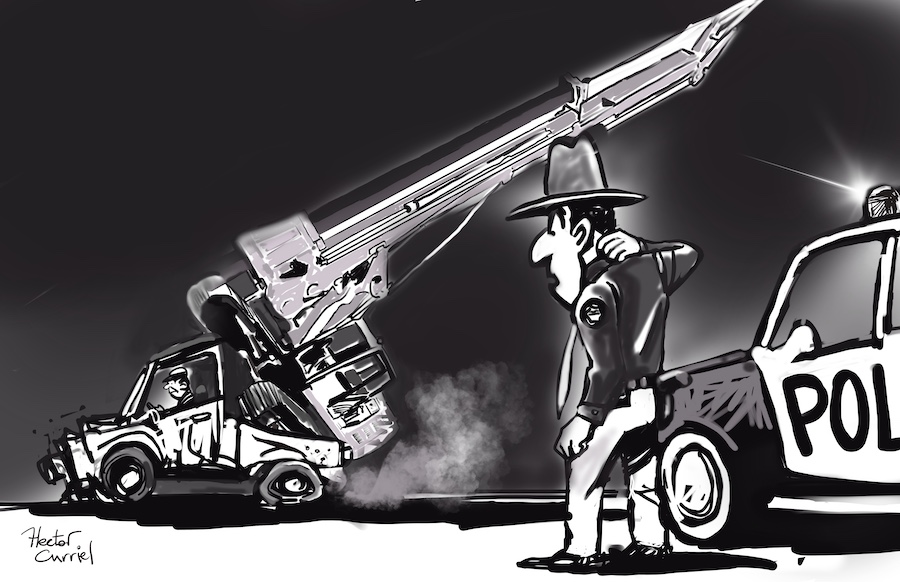
Know Your State’s Laws
The typical four-to-five tie-down points is true in most states. But there are exceptions. There are often restrictions for oversized loads and / or additional regulations. Knowing them is actually part of the planning. The transport team should have all of the proper equipment needed to tie down the load. Ensure that:
- Chains are tight and secure to keep the equipment from shifting during transport.
- You are using the tie-down points specified by the machine’s manufacturer. They are typically marked. When in doubt, refer to the manual or contact the equipment dealer.
- Ensure that the total working load limits of all tie-down components equals minimally fifty percent of the cargo weight.
- The chain grade and its working load limit should not exceed the limit of the boomers.
- There should not be bends, angles, or horizontal twists in the chains.
- Excess chain should be wrapped around the rest of the link to avoid any slack.
- There should be at least four chains used. Two in the front corners and two in the back corners of the trailer.
- Confirm that chain and hook sizes match. This will keep them tight.
The tie-downs are a key component of the post-load inspection.
Department of Transportation (DOT)
Let’s clarify some of the terms used by the Department of Transportation (DOT).
Securement System: All of the parts that are used to secure the heavy equipment on the trailer. This includes the stakes, anchor points, posts, etc. Even the cab can be part of the securement system if it is expected to handle some of the forward movement of the equipment during transport.
Securing Device: Anything used to hold that equipment down. This can include chains, binders, winches, bracing, wire rope, synthetic webbing, and the like.
Tie Down: The securing devices that are attached to the anchor points.
Working Load Limit (WLL): The maximum load any securement system component can handle. The manufacturer of each component should provide its WLL.
On the Road
The National Highway Transportation Safety Administration (NHTSA) reports that in 2018, there were 4,862 fatal crashes involving large trucks (those with a gross weight of 10,000 pounds are more). 2,954 – about 60% — involved tractor-trailers. (Find more stats to scare you witless here.) Sloppy loading and careless driving are not worth the risk.
Now that the equipment is loaded and properly secured, you are ready to hit the road. Here are our tips for a safe trip:
Map the Route
The planned route should be mapped out and actually driven ahead of time. You want the shortest route possible, but a longer route may be necessary to avoid bridges with weight limits, low overpasses, and other restrictions.
Permits
Determining which permits are needed and obtaining them are part of the planning process. Most construction equipment falls into the oversized category. State and local agencies probably know their roads better than you do. Bridges, overpasses, road width, terrain – all the issues that impact the transport of heavy equipment – are known by these government agencies. The point of obtaining permits is to let local agencies know when large loads are on the move. The safety of the public is their greatest concern and responsibility. Heavy hauling increases the risk to the regular folks driving vehicles far smaller than an 18-wheeler.
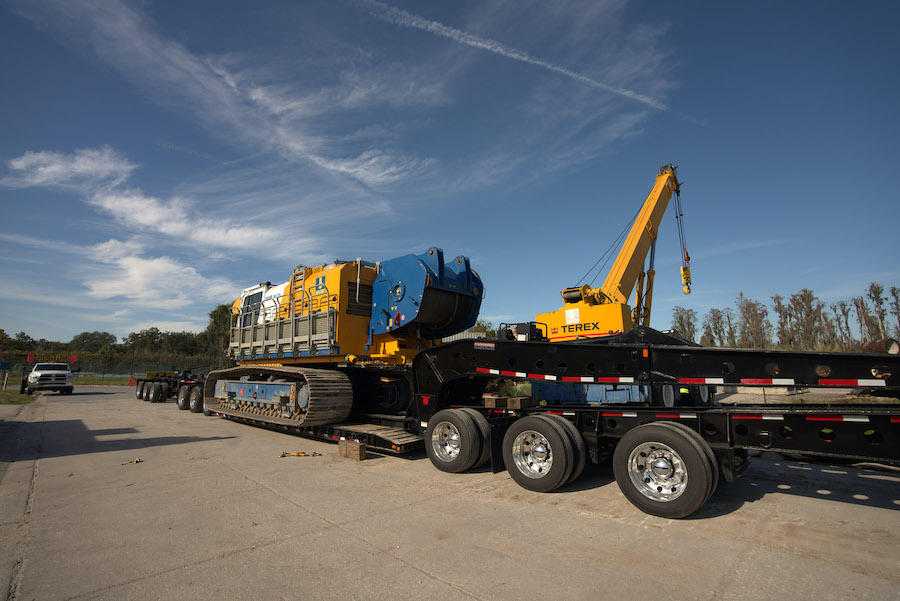
Immobilization
You don’t want that equipment to move during transport. Make sure the equipment’s parking brake is engaged. Use wedges, cradles, chocks – whatever is appropriate – to secure the wheels. There are forces during transport that affect weight distribution of the equipment on deck. For example, when you brake, 80 percent of the equipment’s weight gets applied forward. In fact, every move you make – turning, changing lanes, going uphill – results in the equipment’s weight applying additional pull to the transport vehicle. Machine-specific loading and transportation conditions can be found in the manufacture’s documentation. Or, contact your equipment dealer.
Watch this De Berardinis Heavy Haul transport vehicle take a turn loaded with a Komatsu WA600.
Let Them Know You’re There
Banners, signs, and flashing lights let all the drivers around you know that you are there carrying a huge piece of equipment that will present a hazard to them. In some situations, escort vehicles will be required to ensure other vehicles on the road stay out of the way.
Check-ins and Inspections
You’ll want to ensure that the load hasn’t shifted and the transport equipment is still in good working order as you’re moving along. Industry safety standards recommend:
- The first inspection at the 50-mile mark.
- Inspections every 150 miles or every three hours.
- An inspection each time there is a new driver.
All inspections should be documented in the transport log. Each driver should perform their own inspection. After all, they are taking over the wheel and taking on the responsibility of the load.
Stay in Contact
Stay in contact with the driver throughout the transport. You’ll also want to ensure that the team unloading the equipment is onsite when it arrives.
Unloading the Load
You’ve made it to your destination. Now it’s time to safely unload all that equipment. How you do this should be a documented part of the overall transport plan. Here are some tips to reduce risks associated with unloading:
Prep Team
The transport team members who will help unload should be onsite before the equipment arrives. The area should be clear of anyone not directly involved in the work. Make sure the ground is level and free of debris. Ramps used to take the equipment off the deck should be cleaned. Remember, it’s all about traction – and muddy ramps reduce traction.

Positioning
Once the transport vehicle is parked, carefully line up your clean ramps with the trailer deck. You want to match up joints and get the ramps as close as possible. This may seem obvious, but you get one shot at doing it right. Once that equipment starts moving, you won’t be able to reposition it.
Survey Says
Before breaking down the chain tie points, do a final survey of the equipment. This includes the tires and hitches. Check the tie downs before you release them. If the load has shifted, undoing the straps and chains is dangerous.
Roles and Responsibilities
Just like you did prior to the load, make sure everyone understands what they are supposed to be doing during the unloading process. The supervisor should review the unloading plan with the team prior to the transport’s arrival.
Unloading
Once everything and everyone is in place, you can start the unloading process. Begin unleashing chains and tie bounds. Starting with the rear corners, release one at a time. If excess chain was wrapped around the links, unravel it, then loosen the tie downs. Use the ratchet boomer to reduce tension to avoid a chain snapping up. Take your time.
Back It Out
Slowly and steadily back the equipment down the ramps. The spotter should be positioned so that the operator can see them, but they are as far away from the equipment as possible. Again, anyone who does not need to be in the unloading area should be removed. It is indeed fascinating to see these mammoth machines on the move, but non-transport team workers should gawk at a distance.
Final Inspection
Do a final inspection of the equipment, transport vehicle, tools, ramps, and anchor points before anyone involved in the transport leaves the area. Document your findings.
Debrief
The transport team should discuss and document the heavy haul. This report can be used by managers, supervisors, and team members to tweak the transport planning process. This feedback is also helpful to the heavy hauler you hire for the job.
Equipment Types
The machinery you transport comes in all shapes, sizes, and weights. There are special considerations depending on the type of machine you need to move. Here are a few examples, but a professional heavy hauler will let you know specifically what is needed to transport your particular equipment.
Cranes
Some cranes can be moved locally without disassembling them. If you’re bumping up against transport weight limits, try removing the counterweight. After that, you’ll need to start breaking the crane down further – such as removing the crawlers and the gantry. Make sure the cab is cleared of personal items. Cranes will likely need a permit just due to their height. Over about 12 feet wide and you may need an escort.
Pile Driving and Drilling Rigs
You’ll need to dismantle this type of equipment. The parts should be loaded in the order needed for reassembly at the job site. In some cases, you may need multiple trailers to handle the load. (Shown in this video of De Berardinis Heavy Haul transporting a Bauer drill rig.)
Barges
A barge can’t be driven off the trailer deck. In this video, De Berardinis Heavy Haul demonstrates how to unload a 17-foot barge. A crane is used to lift and hold the barge as the transport vehicle drives out from under it.
Safe Hauling
Should you decide to hire a heavy hauler, make sure they have documented safety procedures in place. For example, De Berardinis Heavy Haul has an incentive program to encourage employees to practice the safety measures they were taught in the company’s training program. Make sure the hauler has insurance and that you understand who is liable should an accident occur. It’s a good idea to have your insurance agent review the hauler’s policy.
Conclusion
Hauling heavy equipment to and from the site is an integral part of the overall construction project. It is a subproject that needs its own plan, risk assessment, and resources. Safely moving equipment requires a knowledgeable team well-versed in loading, transporting, and unloading. It is best to select a professional heavy hauler who can get the equipment you need to the site without injury or damage.
View the complete article here.
Should I hire professionals or attempt to transport heavy construction equipment on my own?
Hiring professionals is recommended due to the complexity of adhering to DOT requirements and minimizing risks, avoiding potential fines and liability risks.
What are the key steps for safely loading and securing heavy equipment for transport?
Ensure a thorough pre-loading inspection, follow safe loading procedures with clear roles, clean loading areas, and proper immobilization, and adhere to DOT regulations for securing systems and tie-downs.














